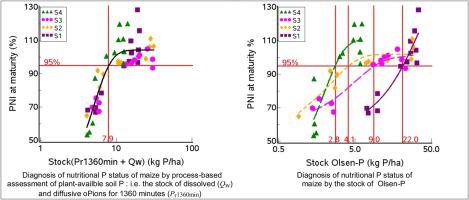当前位置:
X-MOL 学术
›
Eur. J. Agron.
›
论文详情
Our official English website, www.x-mol.net, welcomes your
feedback! (Note: you will need to create a separate account there.)
Calibration of maize phosphorus status by plant-available soil P assessed by common and process-based approaches. Is it soil-specific or not?
European Journal of Agronomy ( IF 4.5 ) Pub Date : 2021-01-01 , DOI: 10.1016/j.eja.2020.126174 Christian Morel , Daniel Plénet , Alain Mollier
European Journal of Agronomy ( IF 4.5 ) Pub Date : 2021-01-01 , DOI: 10.1016/j.eja.2020.126174 Christian Morel , Daniel Plénet , Alain Mollier

|
Abstract The sustainable management of phosphorus (P) fertility in agroecosystems depends on either soil- or plant-based diagnosis methods. Our overall objective was to determine the relationship between the P nutrition index based on a critical P dilution of maize (Zea mays. L.) and indicators of the soil P supply assessed using either a process-based approach or the common chemical extraction of the Olsen’ method. Long-term field experiments on mineral P fertilization, conducted at four sites with contrasting soil types representative of the main types of cropped soils in France, were selected to have deficient to excessive plant-available soil P. Three annual rates of superphosphate including no-P (P0) and about one (P1) and two (P2) times the annual P exported in harvests were studied, while the N and K supply was non-limiting. The shoot biomass (W, Mg DM ha−1) and its P concentration (Pmaize, g P kg−1 DM) were determined at 5–8 dates during the plant cycle after more or less two decades of P applications. Plant-available soil P in the ploughed layer was assessed by a functional and process-based approach that consists in determining together orthophosphate ions (oPions) concentration (CP, mg P L−1), and the oPions amount (Qw) in solution, and the amounts of diffusive oPions bound to soils (Pr, mg P kg−1 soil) that equilibrates the solution over time (t in minutes). We also assessed plant-available soil P by the Olsen’ extraction (Olsen-P). Shoot biomass significantly decreased for the P0 treatment while there was no significant differences between the P1 and P2 treatments. The Pmaize decreased as W increased. The criticalPmaize curve, the minimum Pmaize required to achieve maximum growth, was estimated using all data of the P1 treatment from the four sites: 3.66 × W−0.238 (r² = 0.61 for 78 observations). At maturity, the P nutritional index (PNI), calculated as the measured Pmaize divided by the criticalPmaize, ranged from 53 % to 92 % for the P0 treatment and from 94 % to 128 % for the P1 and P2 treatments. The CP values ranged from 0.04 to 2.25 mg P L−1. The Pr values were described accurately by: Pr = v × CPw × tp for t
中文翻译:

通过常见和基于过程的方法评估的植物有效土壤磷校准玉米磷状态。它是特定于土壤的还是非特定于土壤的?
摘要 农业生态系统中磷 (P) 肥力的可持续管理取决于基于土壤或植物的诊断方法。我们的总体目标是确定基于玉米(Zea mays. L.)的临界磷稀释度的磷营养指数与使用基于过程的方法或普通化学提取方法评估的土壤磷供应指标之间的关系。奥尔森的方法。矿物磷施肥的长期田间试验,在四个地点进行,土壤类型不同,代表法国主要耕作土壤类型,选择了缺乏或过量的植物可用土壤磷。三种过磷酸钙的年率,包括无研究了 P (P0) 和大约一倍 (P1) 和两倍 (P2) 年产量出口的磷,而 N 和 K 的供应是非限制性的。芽生物量(W,Mg DM ha-1)及其磷浓度(Pmaize,g P kg-1 DM)在植物周期中或多或少二十年的磷施用后的第 5-8 天测定。通过功能和基于过程的方法评估耕层中的植物可利用土壤磷,该方法包括一起确定正磷酸盐离子 (oPions) 浓度 (CP, mg PL-1) 和溶液中的 oPions 量 (Qw),以及与土壤(Pr,mg P kg-1 土壤)结合的扩散性物质的量,使溶液随时间(t 以分钟为单位)平衡。我们还通过奥尔森提取法 (Olsen-P) 评估了植物可用土壤磷。P0 处理的地上部生物量显着降低,而 P1 和 P2 处理之间没有显着差异。Pmaize 随着 W 的增加而减少。临界 Pmaize 曲线,使用来自四个地点的 P1 处理的所有数据估计实现最大生长所需的最小 Pmaize:3.66 × W-0.238(78 个观察值的 r² = 0.61)。成熟时,P 营养指数 (PNI) 计算为测量的 Pmaize 除以临界 Pmaize,P0 处理的范围为 53% 至 92%,P1 和 P2 处理的范围为 94% 至 128%。CP 值的范围为 0.04 至 2.25 mg PL-1。Pr 值准确地描述为: Pr = v × CPw × tp for t CP 值的范围为 0.04 至 2.25 mg PL-1。Pr 值准确地描述为: Pr = v × CPw × tp for t CP 值的范围为 0.04 至 2.25 mg PL-1。Pr 值准确地描述为: Pr = v × CPw × tp for t
更新日期:2021-01-01
中文翻译:

通过常见和基于过程的方法评估的植物有效土壤磷校准玉米磷状态。它是特定于土壤的还是非特定于土壤的?
摘要 农业生态系统中磷 (P) 肥力的可持续管理取决于基于土壤或植物的诊断方法。我们的总体目标是确定基于玉米(Zea mays. L.)的临界磷稀释度的磷营养指数与使用基于过程的方法或普通化学提取方法评估的土壤磷供应指标之间的关系。奥尔森的方法。矿物磷施肥的长期田间试验,在四个地点进行,土壤类型不同,代表法国主要耕作土壤类型,选择了缺乏或过量的植物可用土壤磷。三种过磷酸钙的年率,包括无研究了 P (P0) 和大约一倍 (P1) 和两倍 (P2) 年产量出口的磷,而 N 和 K 的供应是非限制性的。芽生物量(W,Mg DM ha-1)及其磷浓度(Pmaize,g P kg-1 DM)在植物周期中或多或少二十年的磷施用后的第 5-8 天测定。通过功能和基于过程的方法评估耕层中的植物可利用土壤磷,该方法包括一起确定正磷酸盐离子 (oPions) 浓度 (CP, mg PL-1) 和溶液中的 oPions 量 (Qw),以及与土壤(Pr,mg P kg-1 土壤)结合的扩散性物质的量,使溶液随时间(t 以分钟为单位)平衡。我们还通过奥尔森提取法 (Olsen-P) 评估了植物可用土壤磷。P0 处理的地上部生物量显着降低,而 P1 和 P2 处理之间没有显着差异。Pmaize 随着 W 的增加而减少。临界 Pmaize 曲线,使用来自四个地点的 P1 处理的所有数据估计实现最大生长所需的最小 Pmaize:3.66 × W-0.238(78 个观察值的 r² = 0.61)。成熟时,P 营养指数 (PNI) 计算为测量的 Pmaize 除以临界 Pmaize,P0 处理的范围为 53% 至 92%,P1 和 P2 处理的范围为 94% 至 128%。CP 值的范围为 0.04 至 2.25 mg PL-1。Pr 值准确地描述为: Pr = v × CPw × tp for t CP 值的范围为 0.04 至 2.25 mg PL-1。Pr 值准确地描述为: Pr = v × CPw × tp for t CP 值的范围为 0.04 至 2.25 mg PL-1。Pr 值准确地描述为: Pr = v × CPw × tp for t











































 京公网安备 11010802027423号
京公网安备 11010802027423号